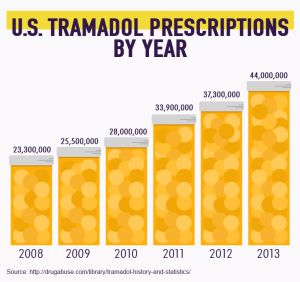Tramadol Addiction & Ultram Abuse Statistics

Tramadol is one of the lesser-known and prescribed opioid-based pain medications, but there is more information becoming available about the medication as it becomes prescribed more often by doctors. Unfortunately, what was at one-time believed to be one of the “safest” opioid medications, Tramadol is now considered just as potentially dangerous to be abused as opioids like Fentanyl and Hydrocodone. Keep reading to find out more about Tramadol addiction and Tramadol drug abuse statistics.
What is Tramadol and How Does it Work?
Tramadol, aka Ultram, is a narcotic-like pain reliever. Tramadol is part of the opioid family of medications and works on the body’s central nervous system. It binds to the brain’s opioid receptors to alter the way the patient receives pain signals. By disrupting the pain signals, the body is relieved of the moderate to severe or chronic pain they are experiencing. Like other opioids, Tramadol use does carry a risk of resulting in the patient developing a tolerance to the drug. When this happens, the user needs more of the drug at higher doses and frequency in order for it to be effective.
When a drug is abused, this habit-forming addiction begins even more quickly.
What Can Cause Tramadol Addiction?
When Tramadol was first widely marketed in the late 1990s, (was first introduced in the late 1970s) researchers believed it to be a safer opioid medication, in comparison to many of the other medications in the opioid family like fentanyl or dilaudid, when it came to looking at the risk for the drug to become habit forming as well as its potential side effects. However, the longer it has been on the market, nearly 20 years later, medical researchers and professionals are finding there are more and more issues with Tramadol.
Aside from the drug addiction risk that comes with Tramadol use, there are also links between the drug use and an increase in the user experiencing seizures, low blood sugar and serotonin syndrome.
The drug becomes habit forming particularly when used by people who have experienced past addictions to drugs, substances, alcohol or other opioids. However, there have been cases of patients using the drug as prescribed to treat chronic pain that develop a higher tolerance for Tramadol over time and find themselves slowly addicted to the drug. Fortunately, through proper weaning techniques lead by a healthcare professional, it is possible to successfully overcome a Tramadol addiction.
Tramadol Abuse Statistics:
- The distribution of Tramadol reached a sharp increase in the years from 2008 to 2012 – rising from 24 million prescriptions for Tramadol to 40 million prescriptions for the drug just four years later, according to a study by a medical research firm.
- Distribution of Tramadol has increased in popularity in other countries as well including England, which saw its numbers double by 2012 to about 11.1 million prescriptions for Tramadol written to patients throughout the country.
- Research shows private practice physicians are the most likely to prescribe Tramadol to help treat moderate to severe and chronic pain.
- There were more than 20,000 emergency room visits throughout the United States as a result of a Tramadol abuse/addiction/overdose situations in 2011.
- In Florida alone, there were an estimated 400 overdoses linked to the abuse of Tramadol in 2011.
- Many medical examiners found the drug was linked to simultaneous abuse of other opioids by the user when they died.
- The Drug Enforcement Administration reported that in 2011, 2.6 million people ages 12 and older used Tramadol for nonmedical purposes. It is believed that the drug is most commonly abused by addicts, chronic pain patients, and health professionals, according to the DEA findings.
In conclusion, while it seems as if Tramadol could be less harmful than other opioid medications, use of the drug should be exercised with caution and only under the direction of a health care professional. If you, or someone you know, is struggling with an addiction to Tramadol there are many options available for the user to wean safely off the drug and overcome the drug addiction. Be sure to contact your healthcare provider right away if you have any questions or concerns about a potential Tramadol addiction.
Sources: www.rxlist.com/
www.medpagetoday.com/
www.ncbi.nlm.nih.gov
drugabuse.com





